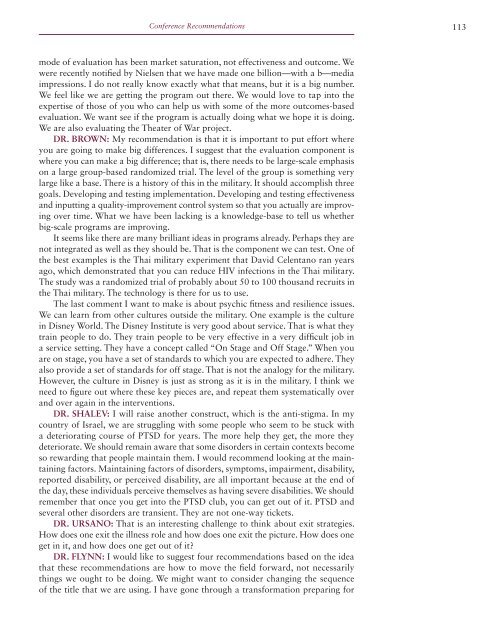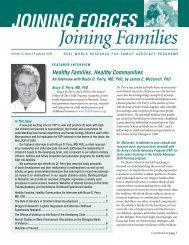stigma and barriers to care - Uniformed Services University of the ...
stigma and barriers to care - Uniformed Services University of the ...
stigma and barriers to care - Uniformed Services University of the ...
Create successful ePaper yourself
Turn your PDF publications into a flip-book with our unique Google optimized e-Paper software.
Conference Recommendations 113<br />
mode <strong>of</strong> evaluation has been market saturation, not effectiveness <strong>and</strong> outcome. We<br />
were recently notified by Nielsen that we have made one billion—with a b—media<br />
impressions. I do not really know exactly what that means, but it is a big number.<br />
We feel like we are getting <strong>the</strong> program out <strong>the</strong>re. We would love <strong>to</strong> tap in<strong>to</strong> <strong>the</strong><br />
expertise <strong>of</strong> those <strong>of</strong> you who can help us with some <strong>of</strong> <strong>the</strong> more outcomes-based<br />
evaluation. We want see if <strong>the</strong> program is actually doing what we hope it is doing.<br />
We are also evaluating <strong>the</strong> Theater <strong>of</strong> War project.<br />
DR. BROWN: My recommendation is that it is important <strong>to</strong> put effort where<br />
you are going <strong>to</strong> make big differences. I suggest that <strong>the</strong> evaluation component is<br />
where you can make a big difference; that is, <strong>the</strong>re needs <strong>to</strong> be large-scale emphasis<br />
on a large group-based r<strong>and</strong>omized trial. The level <strong>of</strong> <strong>the</strong> group is something very<br />
large like a base. There is a his<strong>to</strong>ry <strong>of</strong> this in <strong>the</strong> military. It should accomplish three<br />
goals. Developing <strong>and</strong> testing implementation. Developing <strong>and</strong> testing effectiveness<br />
<strong>and</strong> inputting a quality-improvement control system so that you actually are improving<br />
over time. What we have been lacking is a knowledge-base <strong>to</strong> tell us whe<strong>the</strong>r<br />
big-scale programs are improving.<br />
It seems like <strong>the</strong>re are many brilliant ideas in programs already. Perhaps <strong>the</strong>y are<br />
not integrated as well as <strong>the</strong>y should be. That is <strong>the</strong> component we can test. One <strong>of</strong><br />
<strong>the</strong> best examples is <strong>the</strong> Thai military experiment that David Celentano ran years<br />
ago, which demonstrated that you can reduce HIV infections in <strong>the</strong> Thai military.<br />
The study was a r<strong>and</strong>omized trial <strong>of</strong> probably about 50 <strong>to</strong> 100 thous<strong>and</strong> recruits in<br />
<strong>the</strong> Thai military. The technology is <strong>the</strong>re for us <strong>to</strong> use.<br />
The last comment I want <strong>to</strong> make is about psychic fitness <strong>and</strong> resilience issues.<br />
We can learn from o<strong>the</strong>r cultures outside <strong>the</strong> military. One example is <strong>the</strong> culture<br />
in Disney World. The Disney Institute is very good about service. That is what <strong>the</strong>y<br />
train people <strong>to</strong> do. They train people <strong>to</strong> be very effective in a very difficult job in<br />
a service setting. They have a concept called “On Stage <strong>and</strong> Off Stage.” When you<br />
are on stage, you have a set <strong>of</strong> st<strong>and</strong>ards <strong>to</strong> which you are expected <strong>to</strong> adhere. They<br />
also provide a set <strong>of</strong> st<strong>and</strong>ards for <strong>of</strong>f stage. That is not <strong>the</strong> analogy for <strong>the</strong> military.<br />
However, <strong>the</strong> culture in Disney is just as strong as it is in <strong>the</strong> military. I think we<br />
need <strong>to</strong> figure out where <strong>the</strong>se key pieces are, <strong>and</strong> repeat <strong>the</strong>m systematically over<br />
<strong>and</strong> over again in <strong>the</strong> interventions.<br />
DR. SHALEV: I will raise ano<strong>the</strong>r construct, which is <strong>the</strong> anti-<strong>stigma</strong>. In my<br />
country <strong>of</strong> Israel, we are struggling with some people who seem <strong>to</strong> be stuck with<br />
a deteriorating course <strong>of</strong> PTSD for years. The more help <strong>the</strong>y get, <strong>the</strong> more <strong>the</strong>y<br />
deteriorate. We should remain aware that some disorders in certain contexts become<br />
so rewarding that people maintain <strong>the</strong>m. I would recommend looking at <strong>the</strong> maintaining<br />
fac<strong>to</strong>rs. Maintaining fac<strong>to</strong>rs <strong>of</strong> disorders, symp<strong>to</strong>ms, impairment, disability,<br />
reported disability, or perceived disability, are all important because at <strong>the</strong> end <strong>of</strong><br />
<strong>the</strong> day, <strong>the</strong>se individuals perceive <strong>the</strong>mselves as having severe disabilities. We should<br />
remember that once you get in<strong>to</strong> <strong>the</strong> PTSD club, you can get out <strong>of</strong> it. PTSD <strong>and</strong><br />
several o<strong>the</strong>r disorders are transient. They are not one-way tickets.<br />
DR. URSANO: That is an interesting challenge <strong>to</strong> think about exit strategies.<br />
How does one exit <strong>the</strong> illness role <strong>and</strong> how does one exit <strong>the</strong> picture. How does one<br />
get in it, <strong>and</strong> how does one get out <strong>of</strong> it<br />
DR. FLYNN: I would like <strong>to</strong> suggest four recommendations based on <strong>the</strong> idea<br />
that <strong>the</strong>se recommendations are how <strong>to</strong> move <strong>the</strong> field forward, not necessarily<br />
things we ought <strong>to</strong> be doing. We might want <strong>to</strong> consider changing <strong>the</strong> sequence<br />
<strong>of</strong> <strong>the</strong> title that we are using. I have gone through a transformation preparing for




